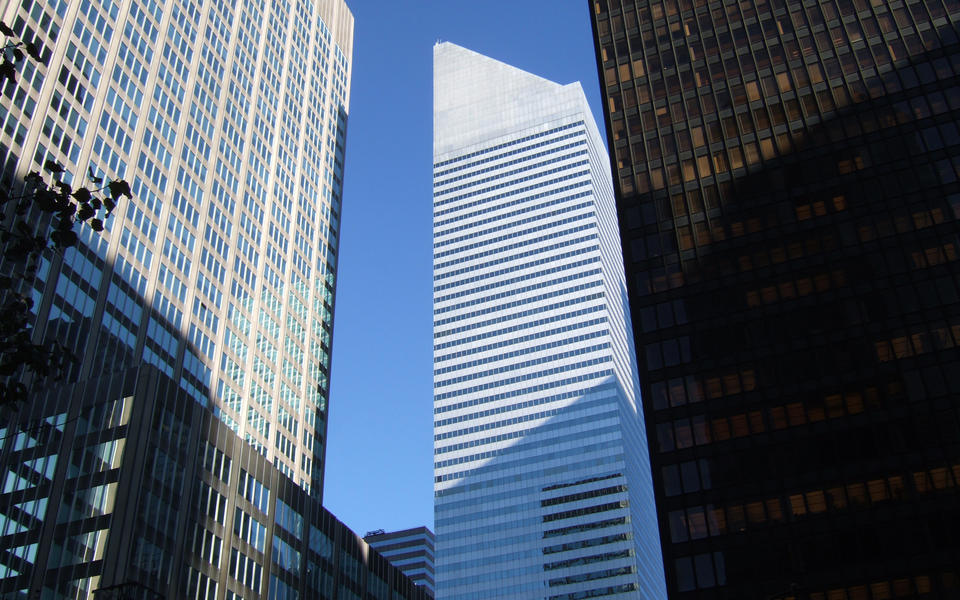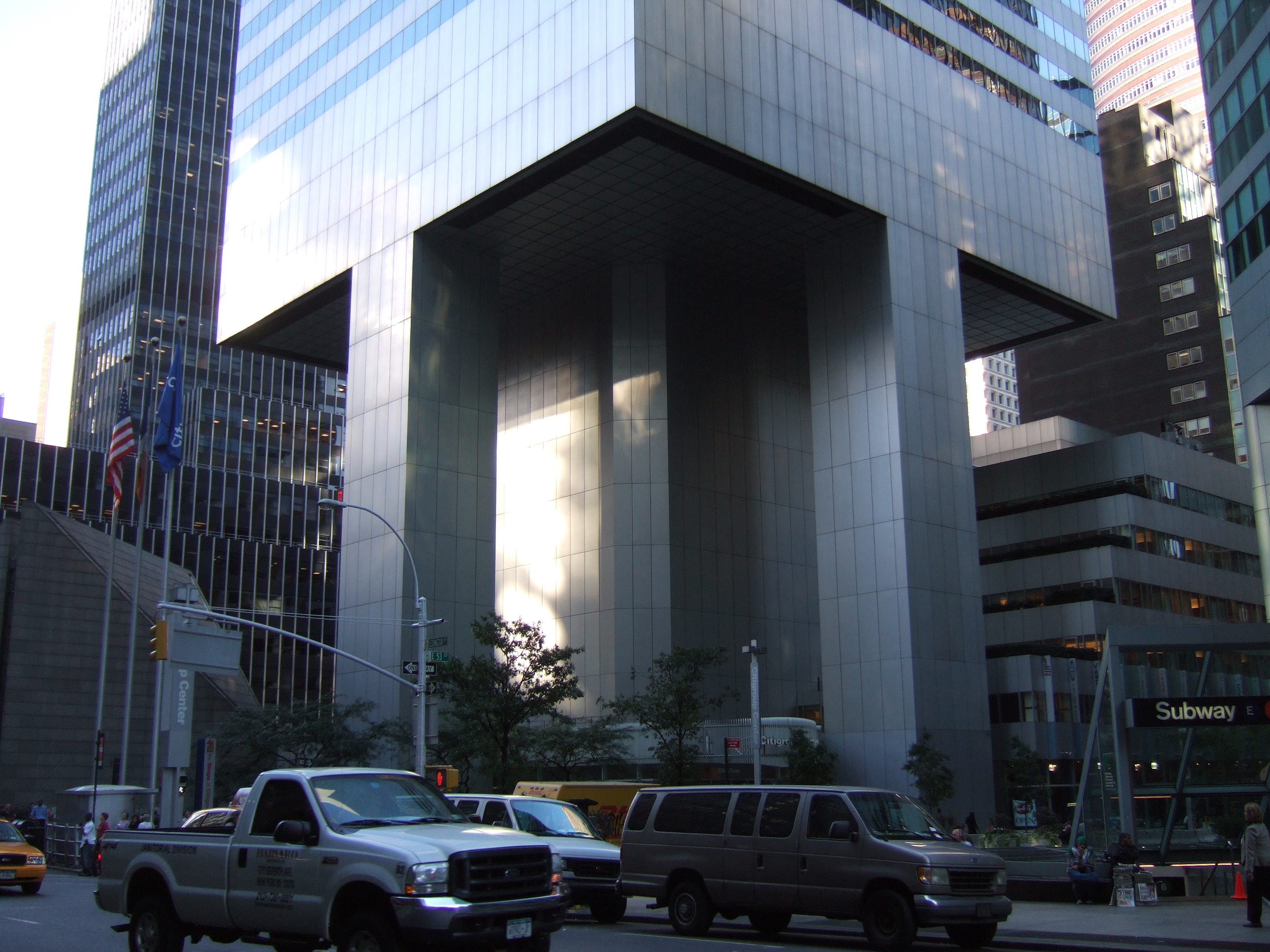Taking Measure
Just a Standard Blog

The iconic white, wedge-topped former Citigroup Center, now known by its address 601 Lexington Avenue.
One of the undergraduate engineering courses that left a deep and lasting impression on me was a course on innovation and aesthetics in engineering taught by David Billington at Princeton University. So, when I read the story of a skyscraper in New York City that had to undergo secret emergency repairs because of question from an engineering student in New Jersey, I knew that the student had to be one of Billington’s. And I knew then that I wanted to come back and investigate this issue in greater detail someday.
The award-winning, wedge-topped, 59-story Citicorp Building in Manhattan, now referred to as 601 Lexington Avenue, features striking columns in the middle of its four sides rather than its corners. This remarkable configuration was due to the existence, at one corner, of a church (now demolished), that refused to be bought out but did grant the use of the space above it. Construction of the building began in 1974 and was completed in 1977. In 1978, a student working on an undergraduate thesis called the chief engineer on the project to ask about the stability of the building under the effect of winds impacting its corners, also known as quartering winds. The chief engineer told the student that the 1970 New York City building code only required consideration of head-on or face winds, i.e., winds that hit the flat sides of the square building.
Still, the question caused him to go back and re-examine the building’s wind tunnel test results. He decided after taking a second look that the just-completed structure needed emergency strengthening of its multi-story diagonal braces to withstand quartering winds. The reinforcements were done at night, in secret, with the building in normal use in the daytime. Tensions peaked on September 1, 1978, as Hurricane Ella bore down on the city with the repairs still unfinished. Fortunately, the storm veered away, and the whole episode remained undisclosed until Joe Morgenstern broke the story in a 1995 New Yorker article.

For the past several years, my fellow NIST wind engineers and I have been developing a new, more accurate method of calculating wind loads on buildings. The method, called Database-Assisted Design (DAD), makes much more effective and direct use of wind tunnel test measurements than was possible before the advent of high-frequency pressure sensors and scanners and fast computers to process the data.
DAD has been adopted as an alternative method in recent building codes, but its use is still not widespread. To attract attention to the method, we thought of applying it to a well-known structure, and the Citicorp Building was the obvious choice. The original wind tunnel tests of the building remain confidential, but we found a way around the problem, by extracting data from wind tunnel tests of a skyscraper of similar proportions.
But first, a little background. The state of the art for calculating wind loads in 1970 is represented by the following table:
Height 1 ft = 0.3048 m | Pressure 1 psf = 47.88 Pa |
| 0-100 | 20 |
| 101-300 | 25 |
| 301-600 | 30 |
| 601-1000 | 35 |
In comparison, DAD uses simultaneous measurements on a wind tunnel model sampled (in this case) by 500 pressure sensors 1,000 times a second for 30 seconds for each of a dozen wind directions. Not only are the wind pressures measured in a much more fine-grained fashion in space over the entire building surface, but the fine resolution in time also captures the shedding of vortices (swirls of air) and the dynamic fluctuations of the chaotic phenomenon that is wind.
These measurements enable the calculation of the responses of the building along and across the wind direction. As it turns out, the across-wind response (due to vibrations induced by vortex-shedding) dominates in the case of face winds. Our results show that, for face winds, the peak overturning moment is greater across wind than along wind. (Moment is the force times the length of the lever arm and is a measure of what makes the building topple over.) In comparison, our data implies that, for corner winds, the peak overturning moments across wind and along wind are equally strong.
A paper that details our work has been published in the Journal of Structural Engineering, and a summary of the results is available at the National Academy of Engineering Online Ethics Center. We were surprised that our results contradicted the original story. According to our calculations, if the building had been safely designed for head-on winds, then it would have been safe for quartering winds, regardless of the connection details, i.e., whether the multi-story diagonal braces were bolted or welded together, and the strengthening of the diagonal braces would have been unnecessary.
It should be noted that, while the designers of the Citicorp Building commissioned their own wind tunnel tests, they did not have the tools at the time to collect many measurements simultaneously, and they only recorded the reaction forces and overturning moments at the base of the building for various wind directions. Thus, they had no information on wind load distribution over height and no accurate basis for member sizing. Still, their measurements of base moments in the 1970s wind tunnel tests should have led them to the same conclusion that corner winds do not govern the design, but face winds do, so the rationale for retrofitting the building needs to be re-examined.
Until that re-examination occurs, at least the student, now known to be Diane Hartley, is finally getting a more complete answer to her question.






I find this article fascinating, and it proves something that I preach to my high school English students. Clear and compelling writing skills are needed in every field.